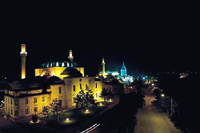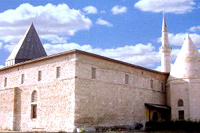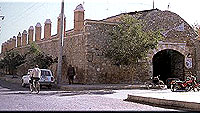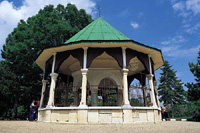Konya
 Mevlana Mausoleum and Dervish Convent (Center): The idea of constructing such a structure was originated from the will of Sultan-ul Ulema Bahaeddin Veledin, father of Mevlana, when he wanted to be burried there after his death in 1230 and the structure turn out to take its shape as a single tomb was built upon his grave. After the death of Mevlana,a tomb was built there by Pervane Muiniddin and his wife Gürcü Hatun.
Mevlana Mausoleum and Dervish Convent (Center): The idea of constructing such a structure was originated from the will of Sultan-ul Ulema Bahaeddin Veledin, father of Mevlana, when he wanted to be burried there after his death in 1230 and the structure turn out to take its shape as a single tomb was built upon his grave. After the death of Mevlana,a tomb was built there by Pervane Muiniddin and his wife Gürcü Hatun.
The tomb has taken its current dervish convent structre as further religious and social architectural additions were carried out. Succeeding to the death of Mevlana that is from 1273 improvements as to the dervish convent building continued and it was converted into a museum after the Proclamation of the Republic. In the museum there are properties belonging to Mevlana and other dervishes as well as valuable samples of hand-painted erchiefs,handwritings, ornaments, wooden works of art and instruments of the Mevlevi music, carpets and pileless carpets.
The most appealing section of the tomb is the Kubbe-i Hadra (Green Vault) above the graves of Hz. Mevlana and his son Sultan Veledin. Inside of the structure built by Architect Bedreddin during Seljuk Period in 1396 is coated with green tiles. The inner walls of the tomb was embellished with plaster relief and designs. The sarcophagus of Hz. Mevlana is one of the superior samples of wooden crafts of the period.Yet this high sarcophagus is above that of his father Sultan-ul Ulema Bahaeddin Veledin's. On the north side of the tomb, there are Semahane( where Mevlevi dervishes perform the sema) and a small mosque constructed by Kanuni Sultan Süleyman in 16th century. 
Şeb-i Aruz Pool, on the other hand, is before the kitchen of the dervish convent. Within the frame of the annual commemoration ceremonies organized in the name of Mevlana, whirling dances of the Mevlevi dervishes( sema) around the pool are performed in certain days called as Şeb-i Aruz (Feast Day). Since the death of Hz. Mevlana was considered as a reunion with God, these days have been renamed as feast days. Most above all Hz. Mevlana is a great humanist, a perfect advocate of peace and a sage figure.
Alaaddin Mosque (Center): Konya is on Alaaddin Hill. The first Seljuk work of art dating back to 12th century, Alaaddin Mosque is not an organic whole since its plan has exposed to various changes in the course of time. On the magnificient pulpit of the first mosque made of ebony tree and dated 1155, there are epitaphs of Sultan Mesut and Kılıçaslan II and the names of Master Mengümberti on them.
Two different periods are observed in the mosque which is thought to have been constructed in accordance to the superiority of its pulpit as the most ancient Seljuk work of art.
Aziziye Mosque (Center): As the first construction built by Mustafa Paşa in 1676 was destructed by a big fire in 1867, this mosque that has remained till today was constructed through the contributions of Abdülaziz and his mother Pertevniyal Hatunun in 1872.
İnce Minareli Mosque and Theology School (Center): On the western slope of the Alaaddin Hill, the theology school(medresseh) was constructed by Seljuk Vizier Sahip Ata in 1260. Despite of the splendid view of the crown gate, it is a plain and unadorned structure.
Sublime stone masonry presenting the grandeur of the Seljuk architecture demonstrate the most praiseworthy art since the French gothic.
 İplikçi Mosque and Theology School (Center): On the eastern side of the Alaaddin Hill, it is located on Alaaddin Road. According to the endowment of the medresseh, it is estimated that the first structure was constructed by the Vizier Şemseddin Altunbanın (Altıapa) during Kılıçaslan II. (through end of the 12th Century). The mosque and medresseh( theology school) was extended and restored by Hacı Ebu Bekir in 1332.
İplikçi Mosque and Theology School (Center): On the eastern side of the Alaaddin Hill, it is located on Alaaddin Road. According to the endowment of the medresseh, it is estimated that the first structure was constructed by the Vizier Şemseddin Altunbanın (Altıapa) during Kılıçaslan II. (through end of the 12th Century). The mosque and medresseh( theology school) was extended and restored by Hacı Ebu Bekir in 1332.
Mihrab, ( nicheof a mosque indicating the direction of Mecca) encircled with two belts adorned with intermingling geometric motifs of tiles with the colors of turquoise and violet; and curled ornamentations( widely used by the Seljuks of Anatolia) made of turquoise and darkblue tiles, is among the most oldest examples of this kind in Anatolia.This edifice is of high esteem since Mevlana Celaleddin Rumi gave lectures in that place.
Sahip Ata Kulliye (Center): Recent reseraches have revealed the fact that Sahip Ata Cami instead stretched out to the facade with double minarets and was a wooden mosque perched on wooden piers. The inscriptions stated that the construction of the building had been commenced by Seljuk Vizier Sahip Ata and that it was a masterpiece of architect Kölük Bin Abdullah. In this respect, it was the oldest Seljuks mosque to be known with its wooden piers .
Completed in 1283, the tomb and the dervish convent later restored to its recent form as a külliye which is a complex of building adjacent to a mosque. Only the magnificient mihrap (niche of the mosque indicating the direction of Mecca) decorated with dazzling mosaic tiles remains to our present times.
Lala Mustafa Paşa Kulliye (Ilgın): Külliye is compsed of three sections as a mosque,imaret( kitchen) and an inn. The mosque constitutes a part of the külliye covering a wide section in the bazaar.
Built by Lala Mustafa Paşa in 1576, the külliye was in some sources said to have been one of the works of art of Mimar Sinan.
Eşrefoğlu Mosque (Beyşehir): On the eastern section of Beyşehir District,it is located at İçeri Quarter. It was constructed between the years in 1296-1299 and the most authentic and the biggest wooden mosques in Anatolian region.
Sublime stone and wooden masonry, designs, adornments of mosaic tiles all together create a harmonious outcome with the latest and the most mature style of Seljuk art.
One of the most splendid samples of tiled minarets, the mihrab of the mosque completely adorned with turquoise, dark blue and violet mosaic tiles is of 6 meters height and 5.50 meters width. The structure reflects the flavour of Beylikler Devri (Eşrefoğlu Domain) with its rich stone masonry, glazed tiles on its interior space, fortifications and wooden decorations on the minber (hooded dais).
Nasreddin Hoca Tomb (Akşehir): On the eastern part of the ramparts of Akşehir province, the tomb is located at the cemetry named with the name of the city. The present appearance of the tomb was acquired by the Akşehir Head Official Şükrü Bey in 1905 as the structure has had difficulty in retaining its authentic view during series of maintances.Only the main tomb of the ancient structure has remained. On the head end of the sarcophagus of the master of humour, there is the date of his death written reversed as 386 symbolizing his jokes.
Sille Siyata Monastery (Center): Among the important centers of the early Christian period, this monastery is 8 km northwest from the center of Konya province. Among the various tombs engraved to rocks by monks, Akmanastır ,Haglos Kharitan (St. Choritan),leads among the others and one of the primary monastries in the world.

Akmanastır (Haglos Kharitan, Sille): It is located between Konya and Sille. Having been composed of buildings forming a circular structure around the engraved rooms, the monastery was constructed in 274 as a dedication to Saint Horion.
Haghia Eleni Church (Sille): Located at Sille Subdistrict and constructed in 327 during the reign of Emperor Konstantinus, it was the first Christian church to be constructed in Anatolian Region. The church is adorned with the figures of Jesus, Virgin Mary and the Apostles. On the interior door of the church, which has been restored and not been in service currently, there is a poem written in Greek language by Turkish expressions stating that the building was constructed in the name of Mikail Arhonkolan.
Lystra (Meram-Hatun Saray):
It is located at Zolkara which is in the west of Konya, at 1 km distance to Hatunsaray town and 400 meters inside from the right side of the main road.
During the reign of the Roman Emperor Agust, Lystra joined the colonized cities of Nykaoline region (6 B.C). Later on it became an important center of episcopacy during Christian times. Though St. Paul had set out to Yalvaça(Antiocheia) from Tarsus, he decided to come to Lystraya and addressed his sermons there. In the very first year one of the ten apostles Artemus became a pishop in Lystra. Today traces of settlement have been witnessed at Lystra ruins.